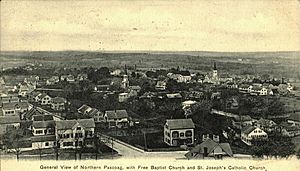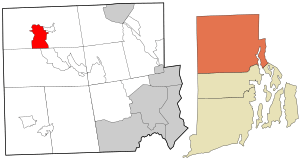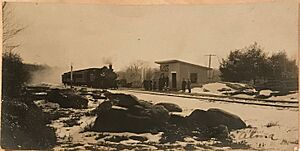Pascoag, Rhode Island facts for kids
Quick facts for kids
Pascoag, Rhode Island
|
|
|---|---|
|
Census-designated place
|
|

Pascoag c. 1900
|
|

Location in Providence County, Rhode Island
|
|
| Country | United States |
| State | Rhode Island |
| County | Providence |
| Area | |
| • Total | 5.56 sq mi (14.41 km2) |
| • Land | 5.07 sq mi (13.13 km2) |
| • Water | 0.49 sq mi (1.28 km2) |
| Elevation | 427 ft (130 m) |
| Population
(2020)
|
|
| • Total | 4,641 |
| • Density | 915.57/sq mi (353.48/km2) |
| Time zone | UTC-5 (Eastern (EST)) |
| • Summer (DST) | UTC-4 (EDT) |
| ZIP code |
02859
|
| Area code(s) | 401 |
| FIPS code | 44-54460 |
| GNIS feature ID | 1218912 |
Pascoag (pronounced PASS-ko or PASS-kog) is a village and a special area counted by the census in Providence County, Rhode Island, United States. It's home to 4,641 people as of 2020. Pascoag is one of eight villages that make up the town of Burrillville.
Contents
Geography
Pascoag is located in Rhode Island, at coordinates 41°57′27″N 71°42′21″W. The village is built around the Pascoag River. This river flows out from the Pascoag Reservoir.
The river drops about 60 feet (18 meters) as it goes through the village. This drop provided a lot of power for factories in the early days. The village covers about 5.5 square miles (14.4 square kilometers). Most of this area is land, with a small part being water.
Population and People
| Historical population | |||
|---|---|---|---|
| Census | Pop. | %± | |
| 2020 | 4,641 | — | |
| U.S. Decennial Census | |||
2020 Census Information
The 2020 United States census counted 4,641 people living in Pascoag. There were 1,811 households, which are groups of people living together. The population density was about 915 people per square mile.
Most of the people in Pascoag were white. A small number were black, Native American, Asian, or Pacific Islander. Some people identified as being from two or more races. About 3.8% of the population was Hispanic or Latino.
About 22% of the people were under 18 years old. About 17% were 65 years old or older. The average age in Pascoag was about 40.7 years.
History
The name Pascoag comes from the Pascoag River. This name likely comes from an old Algonquian Indian word. The word for snake was "askug" or "askoog" in some Native American languages.
Early Days and Industry
Pascoag began in the early 1700s. At that time, a saw mill and other businesses were built in the center of the village. In the 1800s, Pascoag became a town known for making textiles, which are fabrics and cloths. This industry continued until after World War II.
A railroad called the Woonsocket and Pascoag Railroad used to run trains to Pascoag from 1891 until the 1930s. Today, a different railroad company, the Providence & Worcester Railroad, uses part of that line. However, it now stops before reaching Pascoag.
Pascoag in Stories
The famous horror author HP Lovecraft wrote about Pascoag in his story "The Horror at Red Hook" (1925).
Water Quality
In 2001, there was a problem with the drinking water in Pascoag. Tests showed that the water had a chemical called MTBE. This chemical is sometimes added to gasoline. People believed it came from leaking tanks at a local gas station. The issue was fixed over several months. The Pascoag Public Utility District drilled new wells to provide clean water.
Historic sites
- Pascoag Grammar School (built in 1917)
See also
 In Spanish: Pascoag para niños
In Spanish: Pascoag para niños


